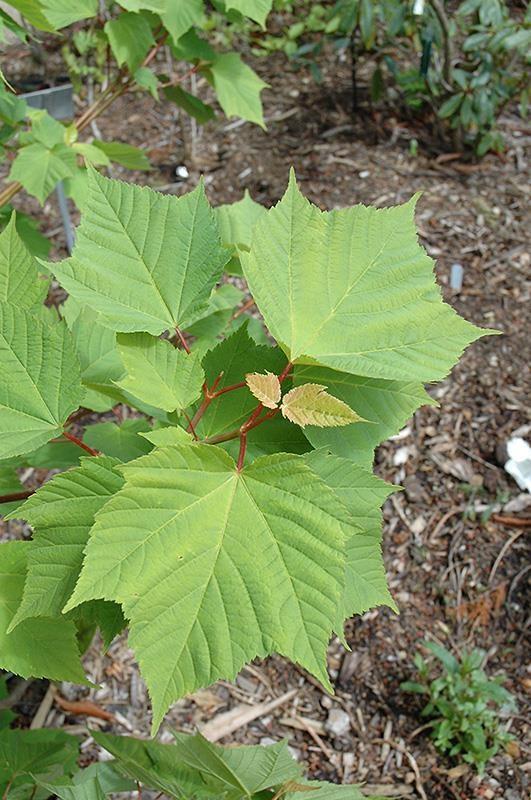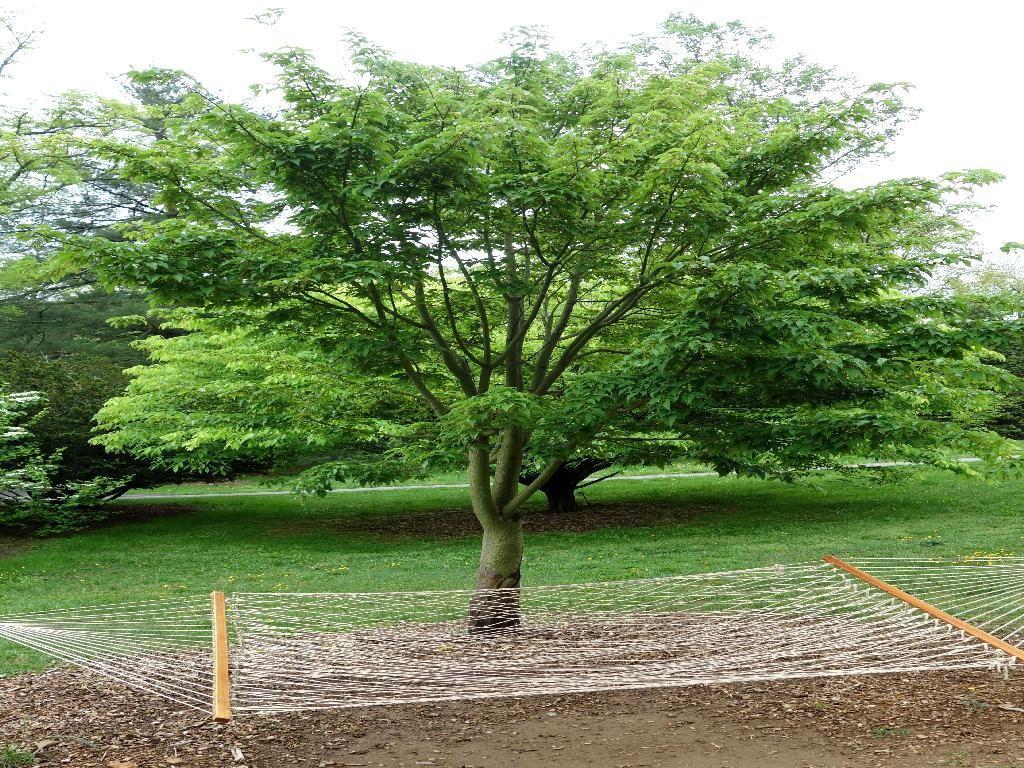Content
Greenbark maple grows in Asian countries, although it can often be found in Russia. By its nature, the plant is unpretentious and has average resistance to cold. Such features, along with a decorative appearance, make the crop interesting for gardeners in the Moscow region and the middle zone.
Description of green maple
Greenbark maple prefers areas with coniferous plantings. A lush crown is formed over decades. Young seedlings stand naked.

The tree's lifespan is 150 years, which is not much compared to other members of the genus.
The green leaves of the greenbark maple resemble linden. They reach 14-16 cm in length and consist of five equal lobes. In the wild, the shape of the leaf blade can be round or jagged. The large buds are colored brown. Veins of a yellowish tint are noticeable on the foliage.
The green maple (acer tegmentosum) gets its name from the wood covering its trunk. The plant tissue has an unusual light green color. In the initial stages, white stripes can be observed on the trunk.
Attention! Interestingly, the texture on the sides resembles lizard skin, although the trunk is very smooth to the touch.
During the flowering period, the crown is decorated with green and yellow buds. The shade may vary depending on weather conditions and lighting levels. Eight stamens are concentrated in their center.

Luscious flowers attract pollinators
The fruits, also called “helicopters,” ripen by September. They contain dozens of seeds waiting in the wings. A gust of wind can transport the fruit a long distance. Once in the soil of a suitable composition, the seed forms a sprout, which in a few years will turn into a young maple.
Winter hardiness of green maple
To determine winter hardiness, they rely on the characteristics of the variety. Some varieties live calmly in areas with temperatures below -40 °C, while others are afraid of cold temperatures of -25 °C. In general, the culture does well in temperate climates.

In some species of green maple you can observe an interesting pattern.
Crown height and diameter
Greenbark maple is a relatively compact plant. The average trunk height is 13 m, but there are specimens up to 16 and even 18 m. The diameter is about 30 cm. The crown width is 10 m.
Application
Green maple is classified as a honey-bearing plant. It is grown in apiaries, providing bees with a large supply of pollen. Wood is also used in landscape design. Group plantings look the most colorful.
Medicines are prepared from maple. The wood is not used in making paper - it serves as an ingredient for tinctures against tuberculosis.
Advantages and disadvantages
Greenbark maple is an ornamental and quite rare plant. It is difficult to find in Western countries. Due to its compactness and beautiful crown, the tree is very popular in China.

The plant has a powerful root system, which further loosens the soil
Pros:
- unusual color and texture of the bark, reminiscent of the skin of a reptile;
- beautiful flowers look spectacular against the background of green foliage;
- bees are attracted by the aroma of the buds, they process the nectar into honey;
- good resistance to heat and negative temperatures.
Minuses:
- maple often gets sick, its immunity is not enough to recover on its own.
Types and varieties
Greenbark maple has several varieties. They differ in characteristics, so when buying seedlings you should pay attention to the name:
- White Tigress. You can see an unusual pattern in the form of stripes on the wood. Sometimes this variety is called birch.
In October, White Tigress foliage turns yellow and then slowly falls to the ground.
- Joe Witt. One of the popular varieties of greenbark maple. Closer to autumn, the leaves lose their rich green color, and the bark becomes light, almost snow-white. Because of this feature, the variety is used in landscape design.
The Joe Witt culture reaches 7 m, loves to grow next to conifers
- Pennsylvanian. The trunk grows up to 10-15 m, the greenbark maple is distinguished by dense shoots and a lush crown. The tree is not afraid of cold weather, and therefore is ideal for planting in northern latitudes.
If the street temperatures drop to -40 °C, the Pennsylvanian species does not need shelter
- Palm-shaped. A shrub variety reaching 4 m in height. The crown is made up of bright foliage, which turns green only in summer.
Greenbark maple is subjected to formative pruning annually.
- Ginnala. Due to its resistance to polluted air, the variety is cultivated in urban areas. It is planted near highways and factories, in parks and other public places.
Greenbark maple Ginnala is suitable for creating a hedge: in summer it will be painted green, and in autumn - red
- Maple of David. It has a neat crown and jagged leaves. There are red villi on the back side.
The height of the Tree of David is 14 m
Planting and propagation of green maple
Greenbark maple is propagated by cuttings or seeds. In the latter case, the process can occur naturally: fruits that ripen by autumn fall into the ground and go into “hibernation.” After a few months, sprouts appear.
When grown independently, the seeds are kept in water and then planted in the garden. The land must be fertilized. The material is left for the winter, protected from the sun. The emerging shoots are left in place or transferred to the greenhouse.
To plant cuttings, cut healthy shoots. The length of the segment should be from 20 to 30 cm. The optimal age is three years. There should be leaves on the cuttings. The stem is cut at an oblique angle and placed in a rooting solution for 24 hours.
After this, the green maple is buried in a fertile substrate. It is advisable to use a complex fertilizer. The young plant is sprayed and covered with a bottle. The shoots should not be exposed to direct sunlight. It is better to place the pot in the corner of the room. They are planted in a permanent location in mid-spring.
Green maple care
The site must be well drained, since greenbark maple cannot withstand stagnant liquid. Planting in lowlands is immediately ruled out due to the proximity of groundwater.Although the culture is undemanding, the soil must be of the highest quality and fertile.
Feeding is applied gradually, the green maple should grow up to four years. Use mineral complexes. Water based on the weather forecast.

In hot summers, moisten up to three times a week, young seedlings are regularly inspected
At the end of autumn, green maple is sprinkled with spruce branches to protect the fragile roots from the cold. In the future, shelter will be optional.
Diseases and pests
The immunity of maple varieties is different. Ornamental varieties are more susceptible to disease. The presence of a white coating and brown spots on the leaves indicates powdery mildew. The causative agent of the disease is a fungus. It is important to prevent its spread, otherwise the entire garden will suffer.

Treat maple against powdery mildew with fungicides (Fitosporin, Bordeaux mixture) according to the instructions
Rare rainfall and lack of care on the part of the owner can lead to marginal necrosis. It appears on the leaves of greenbark maple. The tree dries out, loses its immunity, and begins to wither. The problem can be overcome by restoring agricultural technology.
Sometimes insects parasitize trees: weevils, beetles, ash caps, and scale insects. Pests literally pump out plant juice, disrupting metabolic processes. They are fought with a soap solution; in severe cases, insecticides are used.
Conclusion
Greenbark maple is a plant belonging to the Maple family. This is a moderately demanding crop that prefers fertile soils. The plant is used in folk medicine and landscape design.Although it is common in the East, due to the characteristics of the wood, the tree has become popular in Russia, Europe and the Caucasus.
https://www.youtube.com/watch?v=GxrMm5id_IU














